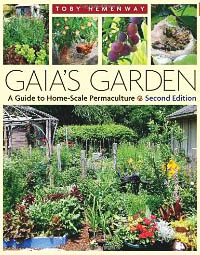Gaia's Garden: A Guide to Home-Scale Permaculture by Toby Hemenway 328 pages
Imagine a garden filled with edible flowers, bursting with fruit and berries, carpeted with scented herbs and tangy salad greens, all blended in an eye-catching palette of color and texture. The flowers also nurture endangered pollinators. Bright-feathered birds share abundant berries and gather twigs for their nearby nests. Each plant plays a role in building soil, deterring pests, storing nutrients, and luring beneficial insects.
This is not a dream. This is your own backyard. Gaia’s Garden: A Guide to Home-Scale Permaculture describes a gardening system that combines the best features of wildlife habitat, edible landscapes, and conventional flower and vegetable gardens into a self renewing landscape that lets nature do most of the work. Rather than mastering your garden with gas-spewing rototillers and chemical fertilizers, let Toby Hemenway show you how to create a backyard ecosystem that balances the needs of humans and nature.
Gaia’s Garden: Table of Contents
Part One: THE GARDEN AS ECOSYSTEM
Chapter 1. INTRODUCING THE ECOLOGICAL GARDEN
Gardens that Really Work with Nature
Why Is Gardening So Much Work?
Beyond–Way Beyond–Natural Gardening
The Natives versus Exotics Debate
Making the Desert Bloom, Sustainably
How to Use This Book
Sidebar: What Is Permaculture?
Chapter 2. A GARDENER’S ECOLOGY
Three Ecological Principles
A Mature Garden
A Few of Nature’s Tricks for Gardeners
Sidebar: Do Plant Communities Really Exist?
Chapter 3. DESIGNING THE ECOLOGICAL GARDEN
The Ecological Design Process
Natural Patterns in the Garden
Sidebars: Some Pear Tree Connections,
Designing the Ecological Garden, Building and Planting a Keyhole Bed
Part Two: THE PIECES OF THE ECOLOGICAL GARDEN
Chapter 4. BRINGING THE SOIL TO LIFE
Soil Life: The First Recyclers
Building Soil Life
Sharing the Wealth of the Soil
Sidebars: Woody Ways to Build Soil, The Ultimate, Bomb-proof Sheet Mulch, Starting Plants in Sheet Mulch
Chapter 5. CATCHING, CONSERVING, AND USING WATER
The Fivefold Path to Water Wisdom
Conserving Water with Catchment
Water Brings the Garden to Life
Sidebars: How to Make a Swale, Planning a Water-Harvesting System, Tips for Using Graywater, Creating a Backyard Wetland
Chapter 6. PLANTS FOR MANY USES
The Many Roles of a Tree
Multipurpose Plants
The Roles of Plants in the Ecological Theater
Annuals and Perennials
Microclimates for the Garden
Nurses, Scaffolds, and Chaperones
Summary: Mixing the Many Functions of Plants
Sidebar: Weeds and Other Wild Food
Chapter 7. BRINGING IN THE BEES, BIRDS, AND OTHER HELPFUL ANIMALS
More Good Buys than Bad
Attracting Beneficial Insects
The Gardener’s Feathered Friend
Other Backyard Helpers
Sidebar: A Gallery of Beneficial Insects
Part Three: ASSEMBLING THE ECOLOGICAL GARDEN
Chapter 8. CREATING COMMUNITIES FOR THE GARDEN
Interplanting and Beyond
Guilding the Garden
Sidebars: lanto Evans’s Polyculture, Jajarkot’s Advanced Polyculture, Growing the Three Sisters Guild
Chapter 9. DESIGNING GARDEN GUILDS
An Intimate Way of Guild-Building
Guilds for Bookworms
Creating a Super-Guild
Guilds Aren’t Perfect
Sidebar: Using Natural Plant Communities to Guide Guild Design
Chapter 1O. GROWING A FOOD FOREST
Experimenting with Forest Gardens
The Seven-Story Garden
How the Food Forest Evolves
Sidebar: A Brief History of Forest Gardens
Chapter 11. PERMACULTURE GARDENING FOR THE CITY
Chapter 12. POP GOES THE GARDEN Choosing the Right Pieces
The Garden Gets Popping
Assembling the Garden Revisited
Sidebar: Ecological Compromises, or You Can’t Make an Omelet . . .
Appendix: A Sampling of Useful Plants Glossary
Bibliography
Resources
Index







